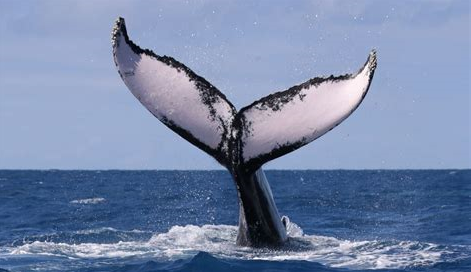Whales and Dolphins
Whales and dolphins, known for their intelligence and playful nature, are captivating marine mammals found in oceans worldwide. These magnificent creatures range from the enormous blue whale to the acrobatic bottlenose dolphin. Renowned for their complex social behaviours and communication skills, whales and dolphins continue to fascinate and inspire, offering glimpses into the mysteries of the deep sea.
Southern Right Whales
Southern right whales are seen from June to November. They leave the polar waters of Antarctica in order to calve in the warmer Ocean along 2000 km of the South African coastline. Adult whales are between 11 and 18 metres long and can weigh between 25 and 66 tons. They feed on zooplankton and other tiny organisms using baleens which can be up to two and a half metres long.
A baleen is a filter-feeding system inside the mouth of the whale. The way it works is the whale first opens its mouth underwater to take in water. The water is then pushed out, and animals such as krill are filtered by the baleen and remain inside the whale’s mouth. The baleen is similar to bristles which consist of keratin.
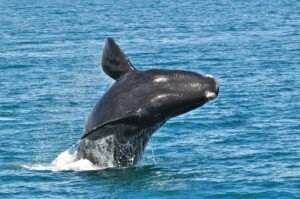
These whales were hunted to the brink of extinction (90% of the species was slaughtered) by the late 1800s 10 whaling stations were operating off the South African coast. Recovery of their numbers has been slow and they are still considered endangered.
Humpbacks
Humpbacks appear along our coast from May to early December. Adult humpbacks are about 16m long and weigh between 25 and 40 tons. They are found close to continental shores and islands, where they breed and feed on many different small marine animals such as squid, krill, herring, pollock, haddock, mackerel, capelin, salmon, and various other fish.
They are one of the most diverse eaters within the baleen whale genus. Their name is derived from their habit of cresting out of the water and diving which accentuates the hump in front of the dorsal fin. Humpbacks can be seen blowing and breaching, close to the shore.
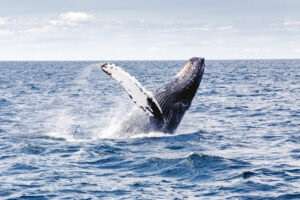
Brydes
Adult brydes grow to between 11.5 and 14 m long and weigh between 12 and 20 tons. They look a bit like large dolphins. Pods consist of between 1 to 7 members which can increase to 30 at the feeding grounds. Brydes feed on krill, squid, and fish such as sardines and anchovies. They travel the whole length of the South African coastline but are not often seen along the Garden Route. You will have the best chance of seeing them by taking a whale-watching cruise from Plettenberg Bay.
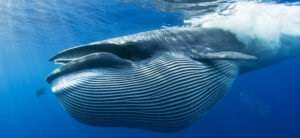
Orcas
Orcas are part of the dolphin family and are distinctly recognisable by their black and white markings. They are highly intelligent and social. They communicate with a wide variety of sounds which can be recognised by them over long distances. They use echolocation to communicate and hunt. Orcas are also called killer whales, it is believed because of the way that they hunt in groups in order to corner large whales.
Their daily diet consists of fish, penguins and marine mammals such as seals, sea lions and occasionally other whales. Orcas are found all over the world and are the most widely distributed marine mammals. They commonly reach a length of 5 to 7 metres for females and between 6 to 8 metres for males. The largest one ever found was 9.8 metres and weighed 10,000 kilos. In the wild, they have been known to live up to 100 years.
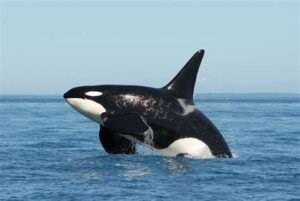
Bottlenose Dolphin
Bottlenose dolphins swim along the shoreline east of Cape Town. These dolphins are one of the largest types of dolphins in South Africa and they reach a length of over 2 metres. There is a larger species called “Tursiops truncates” that reaches a length of over 3 metres, but this species is not often seen close to the shore. A Bottlenose dolphin pregnancy lasts a whole year and there is only one offspring. These dolphins are the ones that are most likely to interact with humans and they can be seen performing tricks in the waters.
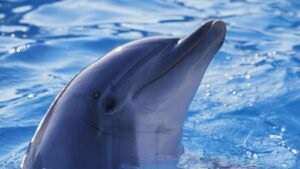
These dolphins have been the subject of scientific studies because of their intelligence and their ability to communicate with sounds and ultrasonic pulses. They are believed to have the longest social memories of any nonhuman species. They have also been shown to recognize the unique whistles of individual dolphins they once associated with some 20 years after being separated from them.
All dolphins are carnivorous and they feed on fish, squid, and other marine invertebrates.
Humpbacked Dolphin
There is a small population of Indo-Pacific humpbacked dolphins that are seen along the South African coast. There are about 1,000 to 1,200 of them. They are the most distinctive types of dolphins in South Africa. They have a long, wide hump below their round, pointed dorsal fins. Humpbacked dolphins are born after 12 months of gestation, however, these dolphins continue to nurse for several years. The dolphins feed on fish, crustaceans, and cephalopods. Their favorite prey consists of mullets, breams, herrings, sardines, and squid. They generally stay away from boats and other human activity.
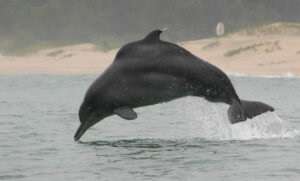
The Common Dolphin
The smallest dolphins in South Africa are called “common dolphins” These are the most abundant cetaceans in the world, with a global population of about six million. These dolphins are the long-beaked variety and they reach a length of about 2.4 meters. Common dolphin offspring nurse for only a few months before being weaned from the mother. This highly social and energetic species prefers shallow, tropical, subtropical, and warmer temperate waters closer to the coast and on the continental shelf. They usually live for forty years or longer. Like bottlenose dolphins, common dolphins often swim near humans and boats.
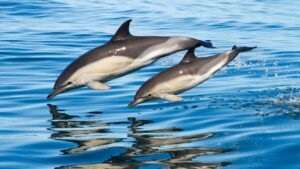
They are usually found in large social groups averaging from 100 to 500 dolphins. These large pods are thought to consist of smaller sub-groups of ten to 30, possibly related individuals or individuals of similar age and sex.
These dolphins feed in relatively shallow waters on small fish such as anchovies, hake, pilchards, sardines krill, and squid. Dolphin groups may work together to herd schools of prey.
Some of the best viewing places for Whales and Dolphins include Pearly Beach Leentjiesklip Beach
Hersham beach, Koggel Bay, anywhere in Hermanus, and many other places.

